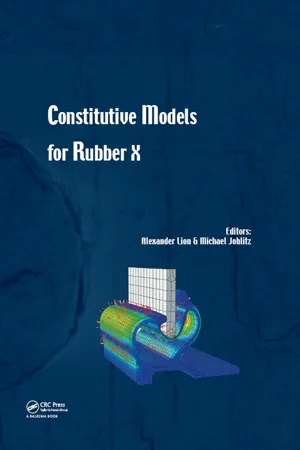
Constitutive Models for Rubber X
Proceedings of the European Conference on Constitutive Models for Rubbers X (Munich, Germany, 28-31 August 2017)
- 626 pages
- English
- ePUB (mobile friendly)
- Available on iOS & Android
Constitutive Models for Rubber X
Proceedings of the European Conference on Constitutive Models for Rubbers X (Munich, Germany, 28-31 August 2017)
About This Book
In order to develop innovative products, to reduce development costs and the number of prototypes and to accelerate development processes, numerical simulations become more and more attractive. As such, numerical simulations are instrumental in understanding complicated material properties like chemical ageing, crack propagation or the strain- and temperature-induced crystallisation of rubber. Therefore, experimentally validated and physically meaningful constitutive models are indispensable. Elastomers are used for products like tyres, engine and suspension mounts or seals, to name a few. The interest in modelling the quasi-static stress-strain behaviour was dominant in the past decades, but nowadays the interests also include influences of environmental conditions. The latest developments on the material behaviour of elastomers are collected in the present volume.
Constitutive Models for Rubber X is a comprehensive compilation of nearly all oral and poster contributions to the European Conference on Constitutive Models for Rubber (Munich, 28-31 August 2017). The 95 highly topical contributions reflect the state of-the-art in material modelling and testing of elastomers. They cover the fields of material testing and processing, filler reinforcement, electromagnetic sensitive elastomers, dynamic properties, constitutive modelling, micromechanics, finite element implementation, stress softening, chemical ageing, fatigue and durability. In the area of rubbery materials and structures, applied research will play an important role also in the coming decades.
Constitutive Models for Rubber X is of interest to developers and researchers involved in the rubber processing and CAE software industries, as well as for academics in nearly all disciplines of engineering and material sciences.
Frequently asked questions
Information
Table of contents
- Cover
- Half Title
- Title Page
- Copyright Page
- Table of Contents
- Foreword
- Foreword (Volume 1)
- Sponsors
- Keynote lectures
- Ageing
- Constitutive models and their implementation in FEM
- Experimental characterisation
- Fracture, fatigue and lifetime prediction of rubber
- Filler reinforcement
- Stress softening
- Rheology and processing
- Special elastomers
- Industrial applications
- Design issues
- Modelling of viscoelastic and hyperelastic behaviour
- Micro-structural theories of rubber
- Tyres and friction
- Author index